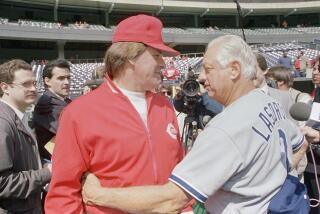How a Point Was Made : Baseball Encyclopedia Challenges Speaker’s Records and His Career Batting Average Is Boosted to .345
- Share via
At last report, Babe Ruth still had 714 home runs and Hank Aaron still had 755. There is no guarantee, however, that those numbers will remain intact. The Baseball Encyclopedia’s investigators are on call, only too willing to challenge and change even the game’s most treasured records.
This much we know for sure: Pete Rose had 4,256 hits.
This much we think we know for sure: Ty Cobb had 4,191 hits.
We are certain about Rose, because, like Aaron, his accomplishments occurred in the glare of the media spotlight, all of them carefully recorded by an army of statisticians pouring information into computer data bases.
We are less sure about Cobb because, like Ruth, he played in baseball’s dark ages, when record keeping was casual and scoring rules imprecise, when the numbers were kept by hand and a case of poor penmanship could affect the accounting.
Now the question. Do you leave the established statistics alone, accepting on faith the figures that appear, aware that some errors might accompany the runs and hits?
The Baseball Encyclopedia refuses to do that, insisting that where it finds mistakes, it will correct those mistakes. So far, Cobb, Ruth and Aaron are OK. The same cannot be said for some of their Hall of Fame colleagues. The ninth edition of the game’s quintessential research work has overhauled a number of them.
Apparently, Tris Speaker’s record was replete with mistakes. When the encyclopedia’s police force got done with him, he had 11 fewer at-bats and one more hit. The changes raised Speaker’s career batting average from .344 to .345, pushing him up two notches on the alltime list, ahead of Ted Williams and Billy Hamilton. While Williams could not have been amused with the change, Hamilton won’t mind. He died in 1940.
Researchers also found that in the second game of a doubleheader on Sept. 4, 1920, the batting lines of Chicago White Sox teammates Eddie Collins and Buck Weaver were reversed. The result was that Collins, who went 2-for-4, had been credited instead with Weaver’s 0-for-3. When corrected, Collins’ batting average for the season went from .369 to .372 and Weaver’s dropped from .333 to .331. That was a year after the Black Sox scandal--Weaver was one of the players barred for life--so how much can be believed about anything else that went on that summer?
The encyclopedia also located another loss for Cy Young, changing his career won-loss record to 511-316. The Baseball Writers are unlikely to change their postseason pitching prizes to the Christy Mathewson Awards, though, since he didn’t get off unscathed, either.
Researchers tagged Mathewson with a loss that had been mistakenly charged to Cy Seymour. The game was played Sept. 26, 1900, half a century before standardized criteria for winning and losing pitchers were formulated. It was not until 1950 that previously imprecise scoring rules were tidied up and specific guidelines established for crediting things like wins and saves.
Is it reasonable then to apply standards adopted after the fact to events that occurred before the fact?
Baseball is not so sure. When the encyclopedia’s eighth edition changed Honus Wagner’s numbers, baseball learned about the alterations only after they were in place. Unhappy about the tinkering, the sport removed its imprimatur from the encyclopedia. The official explanation for the split refers to “distinct philosophical differences with regard to the interpretation of baseball record-keeping.”
The philosophy deals with whether you leave history alone. Rick Wolff, editor of the encylopedia, has always referred to the eight-pound tome as a work in progress, subject to correction. Baseball’s statisticians are happy to correct arithmetical errors but wonder about the policy of making changes based on archaic clippings that were prone to typographical mistakes in the first place.
Wolff does not make the changes casually. Challenges to the records are submitted to a committee of historians composed of Dr. George Kirsch, professor of history at Manhattan College, Bill Deane, senior research associate at the Hall of Fame, and Bill James, a baseball author.
It is important to note that career records are not etched in stone. They are, however, etched in bronze on the plaques in Cooperstown. Those will not change, since the Hall of Fame operates with the disclaimer that its statistics were correct at the time of induction.
The encyclopedia is hardly infallible. Last month, when Mark Koenig died, the last member of the 1927 Yankees was reported as 90 years old based on a birthdate of July 19, 1902 listed in the encyclopedia. In fact, according to Koenig’s daughter, he was born two years after that, on July 19, 1904.
How did the mistake occur?
Poor penmanship, probably.
More to Read
Go beyond the scoreboard
Get the latest on L.A.'s teams in the daily Sports Report newsletter.
You may occasionally receive promotional content from the Los Angeles Times.










